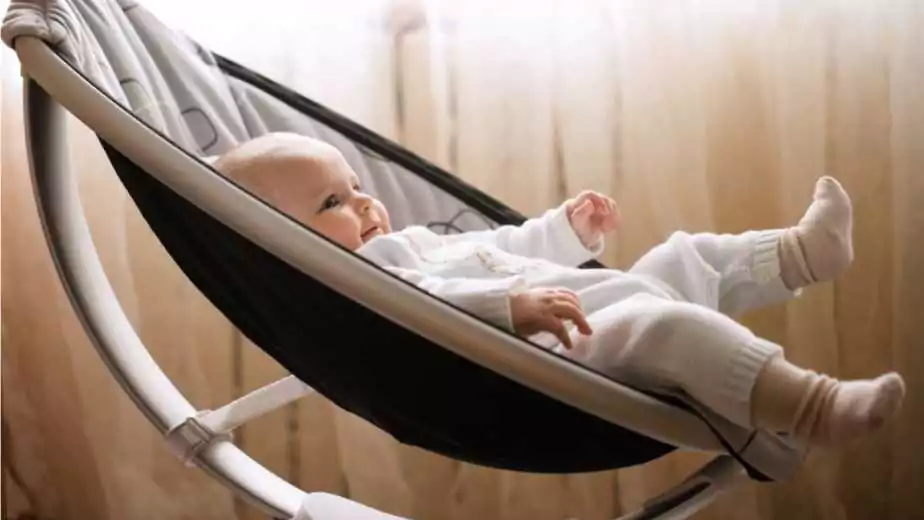What Is A Baby Bouncer And How Can It Help?

Embarking on the journey of parenthood brings excitement and new challenges, especially when it comes to selecting suitable baby equipment. The baby bouncer emerges as a key piece in this puzzle, offering a safe and comforting haven for your baby to relax and engage. For new parents, the wide array of baby products, each with its advantages, might seem overwhelming. This guide focuses on demystifying the baby bouncer, a vital product in your baby care arsenal. We will delve into its significance, ideal usage timelines, and recommended durations, equipping both new and seasoned parents with the knowledge to make well-informed decisions about baby bouncers. Ready to explore the essentials of baby bouncers? Let’s get started!
1 What is a Baby Bouncer?
Definition and Description of a Baby Bouncer
A baby bouncer, also known as a bouncy seat, is a versatile and flexible piece of baby equipment designed to securely hold infants. It’s typically lightweight and consists of a fabric seat attached to a frame with springs or a flexible mechanism. This design allows the seat to bounce gently when the baby kicks or moves, providing a soothing motion that often calms and entertains young ones.
Different Types of Baby Bouncers

- Basic Bouncers: These are the simplest form of bouncers, primarily relying on the baby’s movement to generate a bouncing motion. They are usually more compact and portable, making them a good choice for smaller living spaces or travel.
- Bouncer Swings: These bouncers are a combination of a traditional bouncy seat and a baby swing. They often come with additional features like adjustable speed settings, music, and natural sounds. Bouncer swings can be particularly useful for babies who find constant motion more soothing.
- Activity Bouncers: Designed not just for bouncing but also for play and sensory development, activity bouncers often include toy bars, lights, music, or tactile toys. These are great for engaging and stimulating your baby’s senses and motor skills.
Benefits of Using a Baby Bouncer
Baby bouncers offer numerous benefits for both babies and parents:
For Babies: Bouncers provide a safe and comfortable space where babies can observe their surroundings, interact with toys, and enjoy gentle bouncing motions which can be calming and sleep-inducing. The motion and play elements also contribute to the development of motor skills and sensory processing.
For Parents: One of the greatest advantages of baby bouncers is the freedom they offer parents. With your baby securely placed in a bouncer, you get a few hands-free moments to attend to other tasks or simply take a well-deserved break. It’s also a portable option, allowing parents to keep their baby close by in different areas of the home.
2 When Can I Put My Baby in a Bouncer?

One of the most common questions new parents have is regarding the right time to start using a baby bouncer. While baby bouncers are designed for young infants, there are several important factors to consider to ensure your baby’s safety and comfort.
Appropriate Age to Start Using a Baby Bouncer
The general guideline for introducing a baby bouncer is when your baby is around 3 to 6 months old. However, it’s essential to remember that every baby develops at their own pace, and the right time to start using a bouncer can vary.
Factors to Consider Before Using a Bouncer
- Neck Strength: Before using a bouncer, your baby should have enough neck strength to hold their head up independently. This developmental milestone typically occurs around 3 months of age but can vary.
- Size and Weight: Ensure your baby fits comfortably in the bouncer. Most bouncers have weight and size guidelines that you should adhere to for your baby’s safety.
- Developmental Milestones: Pay attention to your baby’s overall physical and motor development. If they seem comfortable and enjoy lying in a slightly reclined position, a bouncer could be suitable.
Expert Recommendations and Safety Tips
- Consult with Your Paediatrician: It’s always a good idea to discuss with your paediatrician before introducing any new baby gear, including a bouncer.
- Follow Manufacturer Guidelines: Always adhere to the manufacturer’s guidelines regarding age, weight, and size limits.
- Supervision is Key: Never leave your baby unattended in a bouncer. It’s important to keep an eye on them to ensure they’re comfortable and safe.
- Time Limit: Avoid leaving your baby in the bouncer for extended periods. Paediatric experts generally recommend using the bouncer for no more than 20-30 minutes at a time.
- Proper Use: Ensure the bouncer is placed on a flat, stable surface and that all straps and harnesses are securely fastened.
- Watch for Signs of Discomfort: If your baby seems uncomfortable or unhappy in the bouncer, it may not be the right time to use it.
3 How Long Can My Baby Stay in a Bouncer?
Deciding how long your baby can safely and comfortably stay in a bouncer is crucial for their well-being. While baby bouncers are a valuable tool for both entertainment and soothing, it’s important to use them judiciously.

Guidelines on Duration and Frequency of Bouncer Usage
- Duration: As a general rule, it’s recommended to limit time in a bouncer to about 20-30 minutes at a stretch. This guideline helps prevent overstimulation and ensures that your baby isn’t in the same position for too long, which is important for their physical development.
- Frequency: While there’s no strict rule on how often you can place your baby in the bouncer, it’s essential to balance bouncer time with other activities. Reliance on the bouncer could potentially hinder development in other areas.
Importance of Balancing Bouncer Time with Other Activities
Bouncer time should be just one part of your baby’s daily routine. It’s important to balance it with:
- Tummy Time: This is essential for strengthening your baby’s neck, shoulder, and arm muscles.
- Free Play: Time on a play mat allows your baby to move freely and explore their environment.
- Physical Interaction: Engaging directly with your baby through play, talking, and reading is crucial for their emotional and cognitive development.
Signs to Watch for That Indicate It's Time to Take the Baby Out of the Bouncer
- Discomfort or Fussiness: If your baby starts to fuss or cry, it could be a sign they need a change of scenery or position.
- Sleepiness: It’s best to transfer your baby to a crib or bassinet for naps, as sleeping in a bouncer isn’t recommended due to safety concerns.
- Physical Milestones: If your baby starts trying to sit up, roll over, or show signs of increased mobility, it’s time to limit or stop bouncer use to prevent falls or injuries.
4 Choosing the Right Baby Bouncer
Selecting the right baby bouncer involves more than just picking the most attractive design. It’s about finding a safe, comfortable, and appropriate option that suits your baby’s needs and your lifestyle. Here are some key factors to consider:

Factors to Consider When Purchasing a Baby Bouncer
- Safety Features: The most crucial aspect is the safety of the bouncer. Look for a sturdy frame, a secure harness (preferably a 3-point or 5-point harness), and non-slip feet. Also, check if the bouncer adheres to safety standards set by reputable organisations.
- Comfort: The bouncer seat should be well-padded and made of breathable, skin-friendly fabrics. An ergonomic design that supports your baby’s back and head is essential.
- Size and Portability: Consider the size of the bouncer and how much space it takes up in your home. If you plan to move it around often or travel with it, a compact and lightweight model would be ideal.
- Additional Features: Features like vibration, music, and toy bars can be entertaining for your baby but aren’t necessary. Choose based on what you believe your baby will enjoy and benefit from.
Tips for Buying or Borrowing a Second-Hand Bouncer
- Check for Recalls: Before purchasing a second-hand bouncer, ensure it hasn’t been recalled. You can find this information on government or consumer safety websites.
- Inspect for Damage: Examine the bouncer for any signs of wear and tear, broken parts, or missing elements that could compromise its safety.
- Cleanliness: Make sure the bouncer is clean and the fabric is washable. Hygiene is crucial, especially for a baby’s sensitive skin.
- Ask About History: Inquire about how the bouncer was used and stored, as this can affect its condition and longevity.
- Manual and Instructions: Ensure you have access to the manufacturer’s manual for assembly and safety instructions.
5 Safety First: Ensuring Your Baby's Safety in a Bouncer
While baby bouncers are designed with safety in mind, parents must follow certain guidelines to ensure their little ones remain safe and secure. Here are some essential safety tips and common mistakes to avoid:
Essential Safety Guidelines for Using a Baby Bouncer
- Always Supervise: Never leave your baby unattended in a bouncer, even for a short time. Continuous supervision is necessary to monitor their safety and comfort.
- Proper Placement: Place the bouncer on a flat, stable surface. Avoid placing it on elevated surfaces like tables or beds, as the baby’s movement could cause the bouncer to tip over.
- Use Safety Harnesses: Always secure your baby with the provided safety harnesses to prevent them from slipping out or getting into uncomfortable positions.
- Avoid Excessive Bouncing: Gentle bouncing is sufficient for the baby. Vigorous or excessive bouncing can be unsafe.
- Limit Time in Bouncer: As mentioned earlier, limit the time your baby spends in the bouncer to prevent over-reliance on it and to encourage a variety of physical activities.
Common Mistakes to Avoid
- Overloading the Bouncer: Never exceed the weight limit specified by the manufacturer.
- Adding Extra Items: Avoid placing pillows, blankets, or toys that could pose a suffocation hazard in the bouncer.
- Ignoring Age and Developmental Milestones: Using a bouncer for a baby who’s too young or too old for it can be risky.
What to Do in Case of an Emergency?
- Stay Calm: If an accident occurs, stay calm. Your ability to think is crucial in handling the situation effectively.
- Assess the Situation: Quickly assess your baby for any signs of injury. If they are conscious and seem okay, comfort them first.
- Seek Medical Attention: If you suspect any injury or if your baby is unresponsive, seek medical attention immediately.
- Contact Manufacturer: In the event of a product failure, contact the manufacturer and report the incident. This can also help prevent future accidents.
Alternatives to Baby Bouncers
While baby bouncers are a popular choice for many parents, it’s important to have a variety of options for keeping your baby engaged and supported. Different types of baby gear can offer various benefits and experiences. Here are some alternatives to baby bouncers along with their pros and cons:
Playmats
- Pros: Playmats, also known as play gyms, provide a safe space for babies to play and develop motor skills. They encourage tummy time, which is crucial for strengthening a baby’s neck, shoulder, and arm muscles. Many playmats come with sensory toys to stimulate your baby’s development.
- Cons: Unlike bouncers, playmats don’t provide any motion that can soothe a fussy baby. Also, they require your baby to be supervised at ground level, which might not always be convenient.
Swings
- Pros: Baby swings offer a soothing, rhythmic motion that can calm a baby. They often come with multiple speed settings, and music, and can be a great hands-free option for parents.
- Cons: Swings are typically larger and more expensive than bouncers. They also have a limited period of use as babies grow out of them fairly quickly. Like bouncers, swings should not be used for prolonged periods.
Baby Carriers
- Pros: Carriers keep your baby close to you, fostering a sense of security and bonding. They also allow parents to be hands-free while carrying their baby, making multitasking easier.
- Cons: Some parents might find carriers physically straining over long periods. It’s also important to choose an ergonomic carrier to support your baby’s hip development and avoid overuse to ensure varied physical activity.
6 Wrapping Up
In this guide, we’ve explored the essentials of baby bouncers, discussing their types, benefits, appropriate usage age, duration, and safety considerations. We also looked at alternatives and factors to consider when choosing the right bouncer. Remember, while bouncers are a helpful tool, they should be used responsibly, ensuring your baby’s safety and well-being. We invite you to share your experiences or questions about baby bouncers, as your insights are invaluable to fellow parents navigating this journey. Thank you for joining us in understanding the world of baby bouncers – here’s to a safe and joyful parenting experience!
Community Q&A
About This Article
This article has been viewed 93 times.



